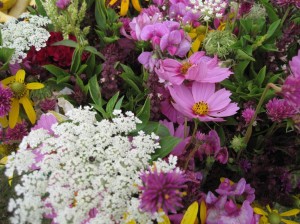 So, last Friday, I bid you well wishes for a weekend of bliss in the garden. I managed only to plant a single row in the vegetable garden on Friday night (because we were also installing the drip irrigation system), and of course the rest of the weekend was a wash-out. But only so much is lost because I had time to read more of Beth Chatto’s The Dry Garden. Kind of ironic, huh?
So, last Friday, I bid you well wishes for a weekend of bliss in the garden. I managed only to plant a single row in the vegetable garden on Friday night (because we were also installing the drip irrigation system), and of course the rest of the weekend was a wash-out. But only so much is lost because I had time to read more of Beth Chatto’s The Dry Garden. Kind of ironic, huh?
Beth Chatto is a fellow gardener and plantswoman in Essex, England. Her book caught my eye in the library, and I began to explore her thoughts, written in 1978, about, essentially, creating a good-looking garden with what you have. She presents sound concepts that make great sense for those of us establishing and advising about gardens that are environmentally sound and conscientious.
Several statements resonated with me immediately. She begins to describe the SOIL in her then-new garden. “In winter, when thoroughly wet, you could slice it neatly with a spade, like lumps of liver…Short of humus, that is decayed vegetable matter, it set like concrete in periods of drought.” She had described the soil in my Georgia garden in the second paragraph of her Introduction! I read on, because this lady is known for the beauty of her gardens. Surely, she knows something I do not!
Drought and the Mediterranean sun were concerns for her. We have a tad more annual rainfall here in Georgia than she does in Essex, but we still have to be mindful that it comes irregularly. We also work with heat and humidity that not all plants can stand up to. She goes on to say, “…I began to realize that it was the plants which had and kept good foliage that made the most satisfying picture in the garden.” Through keen observation of plants in their native settings, she made plant choices that thrived in the conditions that she had. No matter the drought or sun exposure, her selections thrived and her gardens were attractive. “It sounds so obvious,” Beth says, “but is worth stating I think, that I find it best to plant plenty of something that looks good most of the time rather than struggle to keep alive plants which at best only accentuate the fact that what you have to offer them is not what they need.”
That about sums up “right plant, right place” to me! The beauty and success of our gardens starts with observation — the site in which we are working, knowing which plants stand up to existing conditions — and depends upon good gardening practices. (I so appreciated her comments on composting — “I value my compost heaps more than any other organic material I use…” — and loved her practicality — “I must confess I make my heaps pretty haphazardly…”)
So, what are the tried-and-trues for Georgia gardens? What are you recommending to other gardeners as successful garden and landscape additions? I am working on some plant lists for a water-wise publication. I’d love to hear your contributions!
Happy (Gardening) Friday!
Sheri
